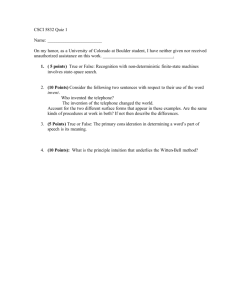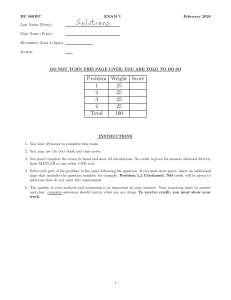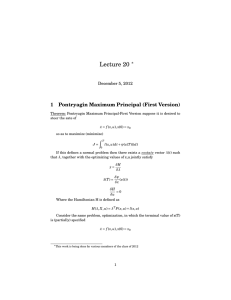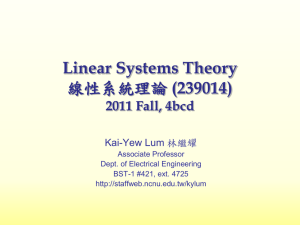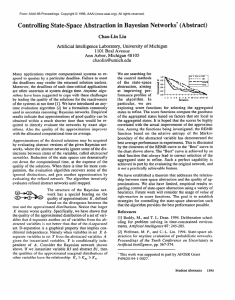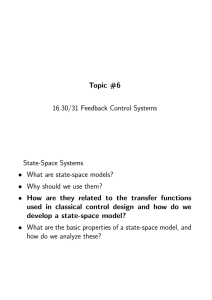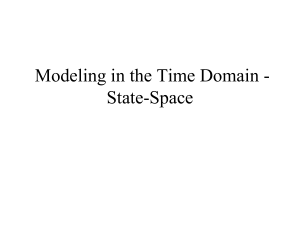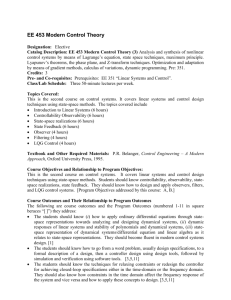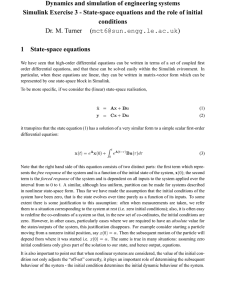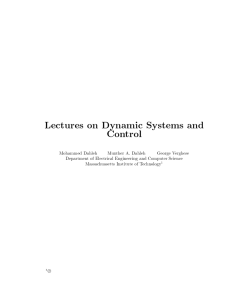Lecture 11 1 Last Time 2
advertisement
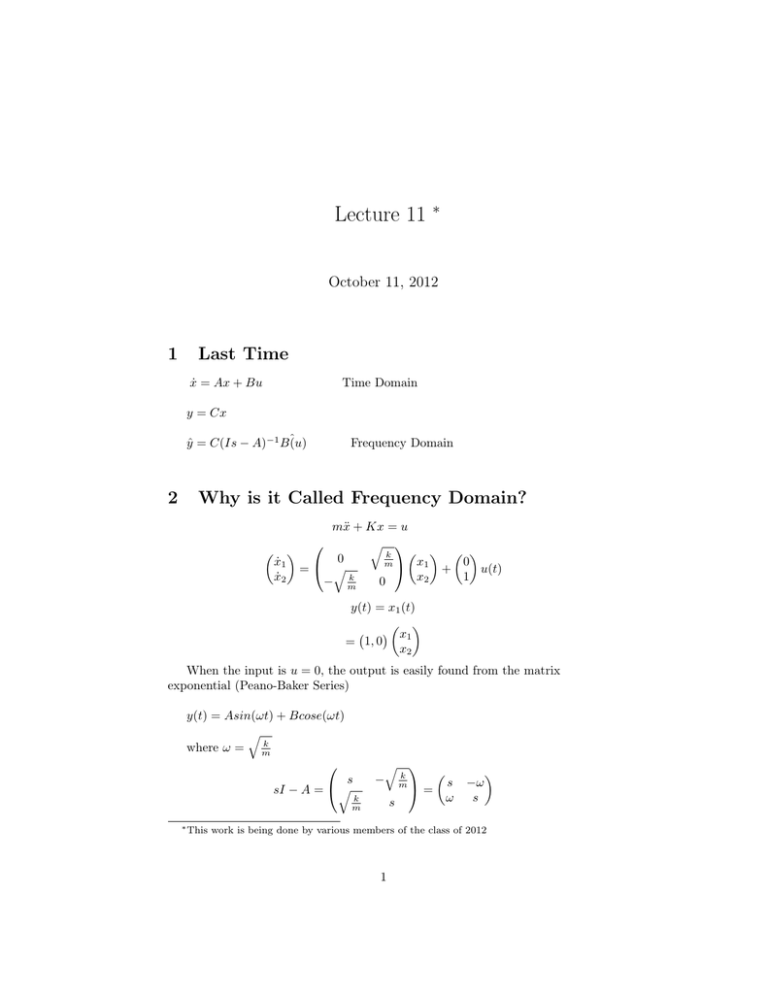
Lecture 11 ∗ October 11, 2012 1 Last Time ẋ = Ax + Bu Time Domain y = Cx ŷ = C(Is − A)−1 Bˆ(u) 2 Frequency Domain Why is it Called Frequency Domain? mẍ + Kx = u q k 0 0 ẋ1 m x1 q + u(t) = x 1 ẋ2 k 2 0 − m y(t) = x1 (t) x1 = 1, 0 x2 When the input is u = 0, the output is easily found from the matrix exponential (Peano-Baker Series) y(t) = Asin(ωt) + Bcose(ωt) q k where ω = m s sI − A = q k m ∗ This q k − m = s ω s −ω s work is being done by various members of the class of 2012 1 Dynamic Systems: State-space control c(sI − A)−1 = 2 1 2 s + ω2 s ω −ω s Using from above (A)(B)(C) q k 0 0 m A= q B= C = 1, 0 1 k − m 0 s ω 2 2 2 2 0 −1 s +ω s +ω c(sI − A) = 1, 0 ω s − s2 +ω2 s2 +ω2 1 ω s2 + ω 2 Let u(t) = sin(wo t). Consider the system forced by u. ŷ = g(s)û(s) = ω ωo s2 + ω 2 s2 + ωo2 =λ ωo ω β s2 + ω 2 s2 + ωo2 where =λ= 3 ωo ω β= 2 ωo2 − ω 2 ω − ωo2 Changing Basis Changing Basis: The effect on time and frequency doman representations, Given ẋ = Ax (1) We have seen that solutions are conveniently represented by eAt λ t e 1 0 0 = P . . 0 0 0 0 e λ2 t 0 eλ3 t . . . . 0 0 . . . . . . . . . . . . . 0 . 0 . 0 P −1 . . . . . eλn t Dynamic Systems: State-space control 3 In the case that A is normal. How do the representations of ẋ = Ax + Bu y = Cx (t) and ŷ = c(sI − A)−1 B û look under a change of basis Let z = T x, where T is any invertable matrix, Then ż = T ẋ = T (Ax + Bu) = T AT −1 z + T Bu y = Cx = CT −1 z In terms of the state variable z, the system is written as ż = Āz + B̄u y = C̄z Ā = T AT −1 B̄ = T B C̄ = CT −1 The frequency domain representation of the transform system is ŷ = C̄(Is − Ā)−1 B̄ û = CT −1 (Is − T AT −1 )T B û = CT −1 (T T −1 s + T AT −1 )T B û = CT −1 (T [Is − A]T −1 )T B û = CT −1 (T [Is − A]−1 T −1 )T B û C(Is − A)−1 B û Dynamic Systems: State-space control 4 4 Realization Theory Realization Theory: How do we get a state space representation from a transfer function? Case 1: SISO (single input single output) system of the form g(s) = 1 sn + an−1 sn−1 + ..... + ao this relates inputs to outputs by ŷ = g(s)û (sn + an−1 sn−1 + ..... + ao )ŷ(s) = û(s) Taking the inverse laplace transforms dn y dn−1 y + a + ..... + ao y(t) = u(t) n−1 dtn dtn−1 First orderizing this in the obvious way. x1 = y x2 = ẏ . . xn = y n−1 0 ẋ1 ẋ2 0 . = . . 0 −ao ẋn 0 x1 . 0 x2 0 . 0 . 0 . + . u(t) . 0 . 1 1 . −an−1 xn x1 x2 y = x1 = 1, ......, 0 . . xn 1 0 . 0 −a1 0 1 . 0 −a2 Case 2: SISO system of the form g(s) = bn−1 S n−1 + ...... + Bo + an−1 sn−1 + ..... + ao sn Dynamic Systems: State-space control 5 Again we wish to find a system such that ŷ = g(s)û or in other words g(s) = ŷ(s) u(s) To find the state space representation, introduce an intermediate variable x̂, and write g(s) = ŷ x̂ x̂ û we write these factors as 1 x̂ = n n−1 û s + an−1 s + ..... + ao ŷ = bn−1 S n−1 + ...... + Bo x̂ The state space representation of x ẋ1 0 1 0 ẋ2 0 0 1 . = . . . . 0 0 0 −ao −a1 −a2 ẋn in terms of u has been seen to be x1 . 0 0 x2 0 . 0 . 0 . + . u(t) . 0 . 1 . −an−1 1 xn x = x1 The time domain rendering of y is then y(t) = bn−1 dn−1 x + bo x(t) dtn−1 = bn−1 xn + ........ + bo x1 The overall system is ẋ1 0 ẋ2 0 . = . . 0 ẋn −ao 1 0 . 0 −a1 0 1 . 0 −a2 . 0 x1 0 x2 0 . 0 . 0 . + . u(t) . 1 . 0 . −an xn 1 Dynamic Systems: State-space control 6 x1 x2 y(t) = bo , b1 , ........bn−1 . xn Starting from the same transfer function we perform long division an−1 + bn−2 −bsn−1 + ..... 2 (sn + an−1 sn−1 + ..... + ao ) bn−1 S n−1 + ...... + Bo bn − 1sn−1 + bn−1 an−1 sn−2 + .... bn−2 − bn−1 an−1 )sn−2 + .... bn−1 s Proper rational functions, in this way, admit Taylor series expansions about infinity λ2 λ3 λ1 + + + .... s s s what about MIMO (multiple input multiple output) systems? g(s) = G(s) = C(sI − A)−1 B −1 1 A = C I− B s s For s sufficiently large, every entry in the matrix A is small hence we may s appeal to writing A I− s −1 A = f( ) s where f (r) = 1 1−r 1 = 1 + r + r2 + .... 1−A −1 A A A2 I− = I + + 2 + .... s s s The G(s) = Note that −1 1 A CB CAB CA2 B C I− B= + + + ..... 2 s s s s s3 Dynamic Systems: State-space control L−1 1 sk+1 7 = tk k! Hence the inverse Laplace transform of G(s) is 2 2 3 3 A t A t CB + C(At)B + C B+C B 2 3! = CeAt B Theorem: Let G(s) be a q × m matrixof rational functions such that the degrees of the numerators exceed the degrees of the denominators for each entry. Then there exist constant matrices A, B, C such that G(s) = C(Is − A)−1 B. Proof let P (s) be the monic polynomial that is the least common multiple (l.c.m) of the denominators (monic → leading coefficient = 1, l.c.m. : if f (s) = (s − λ)(s − β)(s − γ), g(s) = (s − β)(s − δ), then the l.c.m is (s − λ)(s − β)(s − γ)(s − δ); Then P (s)G(s) = E − 0 + E1 s + E2 s2 + Er−1 sn−1 Where r = degree of P Let Om be the m x m zero matrix, let I x m Define A to be the rm x rm matrix Om Im Om Om O Im m . . . A= Om Om Om −po Im −p1 Im −p2 Im be the m x m identity matrix. . Om . Om . . . Im . −pn−1 Im where P (s) = sn + Pr−1 sn−1 + ....... + P1 s + po let Om Om B= . , C = Eo , E1 , ...., Em Om Im Now we will show that G(s) = C(Is − A)−1 B Dynamic Systems: State-space control 8 Note: that (Is − A)−1 B is the solution x̂ to the matrix equation (Is − A)X = B (∗) Partition x̂1 x̂2 x̂ = . . x̂n Compatible with A (i.e. x̂k is m-dimensional) then (*) may be written x̂1 Om x̂2 Om s . . . Om x̂n −po Im Im Om . Om −p1 Im Om Im . Om −p2 Im . Om x̂1 0 x̂2 0 . Om . + . . . . Im . 0 . −pn−1 Im Im x̂n component wise this is sx̂i = x̂i+1 i = 1, ...., r − 1 sx̂r = −Po x̂1 − P1 x̂2 ..... − Pr−1 x̂r + Im = (−Po − P 1s − ..... − Pr−1 S n−1 )x̂1 + Im the last equation may be rendered as S n x̂1 = (−Po − P 1s − ..... − Pr−1 S n−1 )x̂1 + Im x̂ = 1 I −m P (s) Now note that x̂1 x̂2 −1 C(Is − A) B = C . . x̂n = Eo x̂1 + E1 x̂2 + .... + En−1 x̂r = Eo x̂1 + E1 sx̂2 + .... + En−1 sn−1 x̂r Dynamic Systems: State-space control 9 = (Eo + E1 s + .... + En−1 sn−1 )x̂1 = Om Om A= . Om −po Im 1 (Eo + E1 s + .... + En−1 sn−1 ) = G(s) P (s) Im Om . Om −p1 Im Om Im . Om −p2 Im Om . Om Om . Om B = . , C = Eo , E1 , ...., Em . . Om . Im Im . −pn−1 Im Standard controllable realization of G(s)

